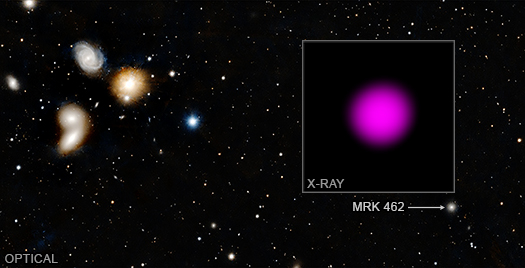Groups & Clusters of Galaxies
"Mini" Monster Black Hole Could Hold Clues to Giant's Growth
The graphic shows X-rays that NASA's Chandra X-ray Observatory detected from the dwarf galaxy Mrk 462. This X-ray emission (inset) is important because it reveals the presence of a growing supermassive black hole within this relatively small galaxy, as described in our latest press release. The mass contained in this black hole — about 200,000 times the mass of the Sun — provides information to astronomers about how some of the earliest black holes in the Universe may have formed and grown billions of years ago.
The background panel is an optical image from the Pan-STARRS telescope in Hawaii. There are several galaxies that are part of the HCG068 galaxy group on the left-hand side of the image. The galaxy that is emitting copious amounts of X-rays, however, is the much smaller galaxy located to the lower right of the image (marked by the arrow). Mrk 462 is a dwarf galaxy because it contains only a few hundred million stars, which means it holds about a hundred times fewer stars than a galaxy like the Milky Way. Black holes are notoriously hard to find in dwarf galaxies because they are usually too small and dim for optical light telescopes to track the rapid motions of stars in the centers.
Astronomers Spy Quartet of Cavities From Giant Black Holes
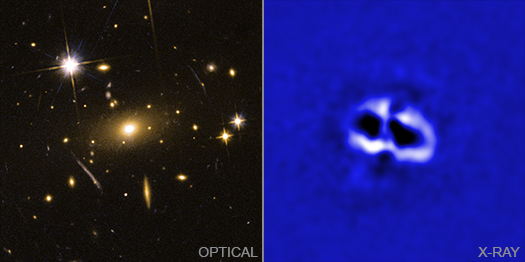
Galaxy Cluster RBS 797
Credit: X-ray: NASA/CXC/Univ. of Bologna/F. Ubertosi; Optical: NASA/STScl/M.Calzadilla
Four enormous cavities, or bubbles, have been found at the center of a galaxy cluster using NASA's Chandra X-ray Observatory, as described in our latest press release. The left panel of this graphic shows an optical image of the galaxy cluster called RBS 797, from NASA's Hubble Space Telescope. Hot gas that envelopes the individual galaxies is invisible in optical light, but it is detected in X-rays by Chandra (right). One pair of cavities can be seen towards the left and right of center in the Chandra image as black oval-shaped regions. The other pair is less distinct, but can be found above and below the center of the image.
Chandra Catches Slingshot During Collision
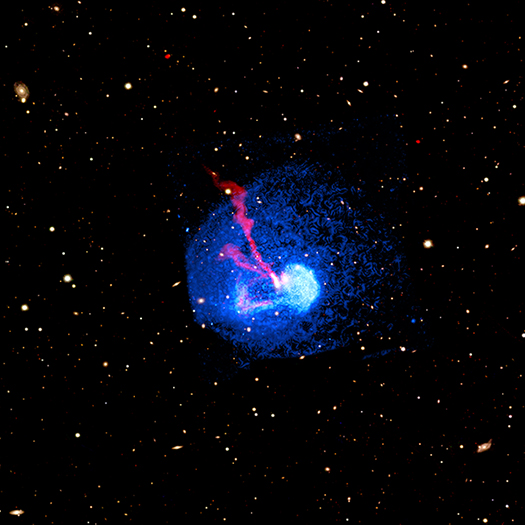
Abell 1775
Credit: X-ray: NASA/CXC/Leiden Univ./A. Botteon et al.; Radio: LOFAR/ASTRON; Optical/IR:PanSTARRS
When the titans of space — galaxy clusters — collide, extraordinary things can happen. A new study using NASA's Chandra X-ray Observatory examines the repercussions after two galaxy clusters clashed.
Galaxy clusters are the largest structures in the Universe held together by gravity, containing hundreds or even thousands of individual galaxies immersed in giant oceans of superheated gas. In galaxy clusters, the normal matter — like the atoms that make up the stars, planets, and everything on Earth — is primarily in the form of hot gas and stars. The mass of the hot gas between the galaxies is far greater than the mass of the stars in all of the galaxies. This normal matter is bound in the cluster by the gravity of an even greater mass of dark matter.
Because of the huge masses and speeds involved, collisions and mergers between galaxy clusters are among the most energetic events in the universe.
In a new study of the galaxy cluster Abell 1775, located about 960 million light years from Earth, a team of astronomers led by Andrea Botteon from Leiden University in the Netherlands announced that they found a spiral-shaped pattern in Chandra's X-ray data. These results imply a turbulent past for the cluster.
Galaxy Cluster Travels Down an Intergalactic Highway
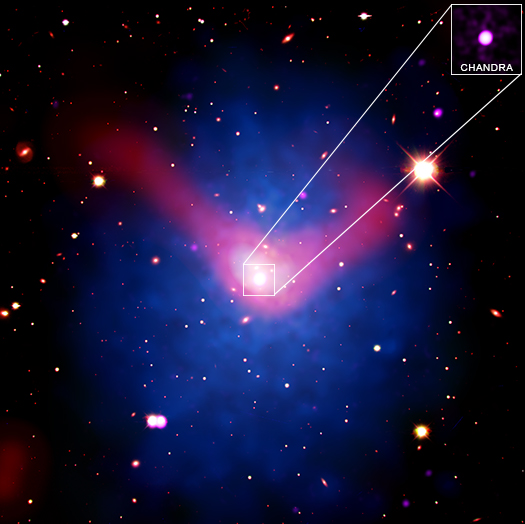
The Northern Clump
Credit: X-ray: (Chandra: NASA/CXC/Univ. Bonn/A. Veronica et al; XMM-Newton: ESA/XMM-Newton); Optical: DES/DOE/FNAL/DECam/CTIO/NOIRLab/NSF/AURA; Radio: CSIRO/ASKAP/EMU
Researchers have found a galaxy cluster acting like a passenger on what astronomers are calling an "intergalactic highway." The cluster is known as the "Northern Clump" and it is located about 690 million light years from Earth. Previously, scientists discovered an enormous filament, a thin strip of very hot gas that stretched for at least 50 million light years. A new study found evidence that the Northern Clump is traveling along this filament, similar to how a car moves along the interstate.
Three's a Crowd: Triple Galaxy Collisions and Their Impact on Black Hole Accretion

Adi Foord
We are pleased to welcome Adi Foord as a guest blogger. Adi is the first author of a pair of papers that are the subject of the latest Chandra press release. She is a Post postdoctoral fellow at the Kavli Institute of Particle Astrophysics and Cosmology at Stanford University. She received her bachelor's degree in Physics & Astronomy from Boston University in 2014, and recently received her Ph.D. in Astronomy & Astrophysics from the University of Michigan (Summer 2020). Adi is a high-energy astrophysicist who is interested in how and which environmental properties impact supermassive black hole accretion and evolution. Most of her work uses X-ray observations of supermassive black holes, and she is currently focusing on systems where two supermassive black holes are in the process of merging.
With the advancement of gravitational wave detectors such as LIGO, we are starting to get real proof that black holes exist, and that some evolve over time via mergers with other black holes. The black holes that gravitational wave detectors like LIGO study are solar mass black holes. As the name and unit imply, these black holes have masses between about five and 100 times that of the sun, and are believed to be formed after the death of a massive star. But what about supermassive black holes, the massive counterparts to solar mass black holes that lie at the center of most massive galaxies? With the groundbreaking image supplied by the Event Horizon Telescope (EHT) in April 2019, we were given proof that supermassive black holes exist as well. But in order to have proof that they merge, and emit gravitational waves, we will have to wait for results from pulsar timing arrays (PTAs) and space-based interferometry (such as LISA). This is because the expected gravitational wave frequencies the supermassive black hole mergers are theorized to emit are outside the range of LIGO.
On the Hunt for a Missing Giant Black Hole
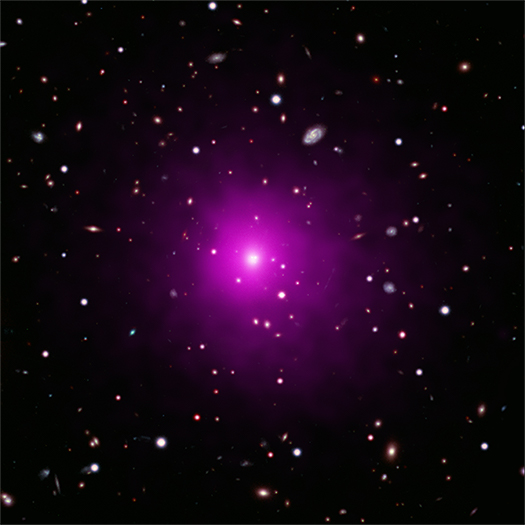
Abell 2261
Credit: X-ray: NASA/CXC/Univ of Michigan/K. Gültekin;
Optical: NASA/STScI and NAOJ/Subaru; Infrared: NSF/NOAO/KPNO
The mystery surrounding the whereabouts of a supermassive black hole has deepened.
Despite searching with NASA's Chandra X-ray Observatory and Hubble Space Telescope, astronomers have no evidence that a distant black hole estimated to weigh between 3 billion and 100 billion times the mass of the Sun is anywhere to be found.
This missing black hole should be in the enormous galaxy in the center of the galaxy cluster Abell 2261, which is located about 2.7 billion light years from Earth. This composite image of Abell 2261 contains optical data from Hubble and the Subaru Telescope showing galaxies in the cluster and in the background, and Chandra X-ray data showing hot gas (colored pink) pervading the cluster. The middle of the image shows the large elliptical galaxy in the center of the cluster.
History of SpARCS1049

Carter Rhea
We welcome Carter Rhea as our guest blogger and a co-author of a paper that is the subject of our latest press release. Carter completed his undergraduate degree in astronomy at the College of Charleston in Charleston South Carolina. Afterwards, he obtained a master’s degree in scientific computing and computational mechanics at Duke University. Instead of continuing with a PhD, he decided to return to astronomy. He just finished his master’s degree at l’Université de Montréal and will be continuing his Ph.D. there.
Galaxy clusters are an exceptional class of object – they are the largest structures in the Universe held together by gravity, and contain hundreds or thousands of individual galaxies, unseen dark matter, and a vast amount of hot gas that gives off X-rays.
In 2015, a team of astronomers led by Tracy Webb at McGill University in Montréal released the first study of SpARCS1049, which was quickly recognized as an exceptional member of this exceptional class. The team’s optical, infrared, and ultraviolet observations of this galaxy cluster revealed a complex structure of clumpy, cool emission regions forming a tail that trails away from the cluster’s central galaxy. As a reminder, galaxy clusters are the largest structures in the Universe held together by gravity. They are made up of three main things: hundreds or thousands of individual galaxies, unseen dark matter, and a vast amount of hot gas that gives off X-rays.
These regions, also known as “tidal tails,” are usually the remnants of a smaller galaxy that has merged with the central galaxy. Studying the near-infrared images revealed a truly surprising fact: the region around the central galaxy was forming stars at a prodigious rate of nearly 900 solar masses per year! (For comparison, our own galaxy -- the Milky Way -- is creating stars at a pedestrian rate of 3 solar masses per year.)
Bending the Bridge Between Two Galaxy Clusters
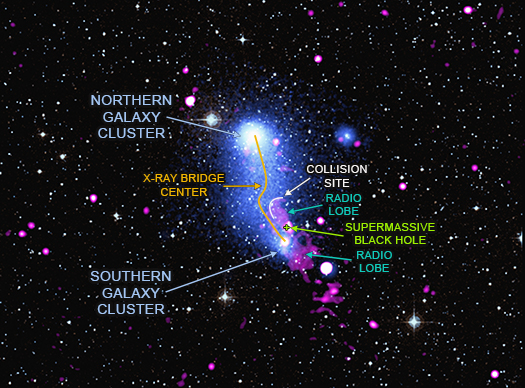
Abell 2384
Credit: X-ray: NASA/CXC/SAO/V.Parekh, et al. & ESA/XMM-Newton; Radio: NCRA/GMRT
Several hundred million years ago, two galaxy clusters collided and then passed through each other. This mighty event released a flood of hot gas from each galaxy cluster that formed an unusual bridge between the two objects. This bridge is now being pummeled by particles driven away from a supermassive black hole.
Galaxy clusters are the largest objects in the universe held together by gravity. They contain hundreds or thousands of galaxies, vast amounts of multi-million-degree gas that glow in X-rays, and enormous reservoirs of unseen dark matter.
A Very Mysterious Direction in the Universe

Konstantinos (Kostas) Migkas
We are pleased to welcome Konstantinos (Kostas) Migkas as a guest blogger. Kostas is a doctoral researcher in the Argelander Institute of Astronomy of the University of Bonn, Germany, and led the study that is the subject of our latest press release. He received his Bachelor's degree in Physics from the Aristotle University of Thessaloniki, Greece, in 2015. Then he moved to Germany and Bonn to obtain his Master's degree in Astrophysics in 2017. He started his PhD by the end of the same year in the group of Prof. Thomas Reiprich working on cosmology with galaxy clusters, exploiting a novel method they designed to study one of the key principles of cosmology.
Our understanding of the Universe has significantly improved in the last 25 years. The accelerating expansion of the Universe, the detailed observation of the leftover relic radiation from the Big Bang (cosmic microwave background, or CMB), the in-depth study of the Universe's structure and the unfolding of the cosmos in the whole range of the electromagnetic spectrum are some of the accomplishments that led astronomers to precisely constrain the so-called cosmological parameters. The latter describe the properties of the Universe in various ways. These include: how much "normal" and "dark" matter the Universe contains, the nature of the mysterious dark energy, and maybe most importantly, the expansion rate of the Universe.
To push cosmological knowledge forward, scientists have to inevitably make some assumptions about the Universe. One of the most fundamental ones is that it acts the same way towards every direction of the sky. Practically, this means that the behavior of the astrophysical objects, for instance galaxies or clusters of galaxies, should look the same no matter where we look. It also means that the cosmological parameters, including the expansion rate of the Universe, must be the same independent of the direction. We call this property "isotropy".
How To Do Particle Physics With Chandra
We are pleased to welcome Chris Reynolds as our guest blogger. Chris is a professor in the Institute of Astronomy at the University of Cambridge in the United Kingdom, and led the study that is the subject of our latest press release. He received his Bachelors degree in Physics and Theoretical Physics from the University of Cambridge in 1992, and continued in Cambridge to graduate with his PhD in astronomy in 1996. He then moved to the University of Colorado Boulder for five years as a post-doctoral fellow and Hubble Fellow, before joining the faculty of the University of Maryland's Department of Astronomy. In 2017, after 16 years as a professor at the University of Maryland, he was lured back to Cambridge to take up the position of Plumian Professor of Astronomy and Experimental Philosophy. Chris is a high-energy astrophysicist who mainly works on the properties of supermassive black holes, although he has taken a detour into particle physics with his latest work, which is the subject of this blog post.
A little over 200 million light years from us lies the Perseus cluster, a swarm of a thousand galaxies trapped within the space of just a couple of million light years by the gravitational field of a massive ball of dark matter. This gravitational field doesn't just confine the galaxies. It also holds onto an atmosphere of hot (40-60 million Kelvin) gas that fills the space between the galaxies; this matter is known as the “intracluster” medium. At the center of all of this lies the unusual galaxy NGC1275, and at the center of this galaxy is a supermassive black hole that is driving powerful jets out into the intracluster medium. When my team observed the active galactic nucleus (AGN) in NGC1275 with the Chandra X-ray Observatory in late 2017, we thought that our focus would be the properties of this black hole and how it interacted with its surroundings. Little did we know that we'd be publishing a paper on particle physics, setting the tightest limits to date on light axion-like particles with implications for string theory!

